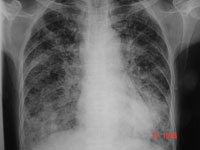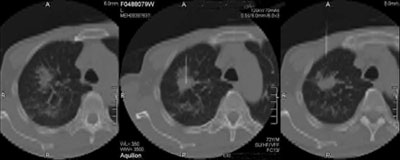Common Conditions
Lung Cancer
Lung Cancer is one of the leading causes of cancer deaths in Singapore. It is the second and third most common cancers in the males and females respectively.
Signs and Symptoms
Lung cancer usually does not cause signs and symptoms in its early stage. They typically occur when the disease is advanced. They may be:
- Chronic cough
- Changes in chronic cough or smoker’s cough
- Coughing up blood
- Shortness of breath
- Chest pain
- Wheezing
- Hoarseness
- Recurrent chest infection
Types of Lung Cancer
There are two types of lung cancer:
- Small cell lung cancer: It occurs almost exclusively in heavy smokers and is less common than non-small cell lung cancer
- Non-small cell lung cancer: This is an umbrella term for several types of lung cancers that behave in a similar way. This includes squamous cell carcinoma, adenocarcinoma and large cell carcinoma.
Chest x-ray of a patient with cancer of the lung
Causes and risk factors
Smoking
Smoking remains the greatest risk factor for lung cancer. The risk increases with the number of cigarettes smoked each day and the number of years of smoking. Quitting at any age will significantly lower the risk.
Sex
Current or former women smokers have a greater risk than men who have smoked the same amount. Perhaps they have greater susceptibility or inhalation, are less likely to quit or there is a possible role by estrogen.
Exposure to secondhand smoke
Even if you do not smoke, the risk of lung cancer increases with exposure to secondhand smoke.
Exposure to radon gas
Radon is produced by the natural breakdown of uranium in soil, rock and water that eventually becomes part of the air you breathe.
Exposure to asbestos and other chemicals
Workplace exposure to asbestos and other substances such as arsenic, chromium, nickel and tar soot can increase risk especially if you are a smoker.
Family history of lung cancer
People with a parent, sibling or other first-degree relative with lung cancer have an increased risk of the disease.
Diagnosis
Imaging tests
An X-ray image of the lungs may reveal an abnormal mass. A CT thorax scan can reveal small lesions.
Sputum cytology
If you are producing sputum, looking at the sputum under the microscope can sometimes reveal the presence of lung cancer cells.
Tissues samples
A sample of abnormal cells may be removed in a procedure called biopsy. This can be performed in the following ways:
- Bronchoscopy: Your doctor examines abnormal areas of the lung using a lighted tube that is passed down the throat and into the airway.
- Mediastinoscopy: An incision is made at the base of neck and surgical tools inserted behind breastbone to take samples from lymph nodes.
- Percutaneous needle biopsy: A doctor uses CT images to guide a needle through your chest and into a suspicious nodule to collect cells.
- Lymph node biopsy: The cells can be sampled from enlarged peripheral lymph nodes.
Needle biopsy of lung cancer
Staging
Once your lung cancer is diagnosed, your doctor will work to determine the extent of the cancer. This will help to decide the most appropriate treatment. Staging tests may include imaging procedures that allow your doctor to look for signs that cancer has spread beyond your lungs, such as MRI, PET and bone scans.
Stages of non-small cell lung cancer
Stage 1
Cancer has invaded the underlying lung tissue but has not spread to the lymph node.
Stage 2
Cancer has spread to neighboring lymph nodes or invaded the chest wall.
Stage 3a
Cancer has spread from the lung to lymph nodes in the center of the chest
Stage 3b
Cancer has spread locally to areas such as heart, blood vessels, trachea and esophagus (all within the chest) or to lymph nodes in the area of the collarbone or to the tissue that surrounds the lung within the rib cage, pleura.
Stage 4
Cancer has spread to other parts of the body, such as liver, bones or brain.
Stages of small cell lung cancer
Limited
Cancer is confined to one lung and its neighboring lymph nodes.
Extensive
Cancer has spread beyond one lung and nearby lymph nodes and may have invaded the other lung, more remote lymph nodes or other organs.
Treatment
Your and doctor will choose a treatment regimen based on a number of factors such as your overall health, the type and stage of cancer and your own preferences. Treatment options include surgery, chemotherapy, radiation, targeted drug therapy and palliative care.
Treatment options of non-small cell lung cancers
| Stage | Common options |
|---|---|
| I | Surgery |
| II | Surgery, chemotherapy, radiation |
| IIIA | Combined chemotherapy and radiation, sometimes surgery based on results of treatment |
| IIIB | Chemotherapy, sometimes radiation |
| IV | Chemotherapy, targeted drug therapy, clinical trials, supportive care |
Treatment options for small cell lung cancers
| Stage | Common options |
|---|---|
| Limited | Combined chemotherapy and radiation, sometimes surgery |
| Extensive | Chemotherapy, clinical trials, supportive care |
Surgery
The surgeon will remove the cancer and a margin of healthy tissue. Procedures:
- Wedge resection: a small section that contains the tumour along with a margin of healthy tissue is removed.
- Lobectomy: the entire lobe is removed.
- Pneumonectomy: an entire lung is removed.
Chemotherapy
Chemotherapy uses drugs to kill cancer cells. One or more drugs may be administered through your vein in your arm or taken orally. A combination of drugs is given in a series of treatment over a period of weeks or months, with breaks in between. It is used as first line treatment or as an additional treatment after surgery.
Radiation therapy
This uses high-powered energy beams to kill cancer cells. Radiation can be directed at the cancer area from outside your body (external beam radiation) or it can be put inside needles, seeds or catheters and placed inside the body near the cancer (brachytherapy). It can be used alone or along with other treatments. It can be used to lessen the side effect of lung cancer.
Targeted drug therapy
These are newer cancer treatment that target specific abnormalities in cancer cells. This can be used for advanced and recurrent non-small cell lung cancer that has not been helped by chemotherapy.
Supportive (palliative) care
This means that you will receive treatment to cease the symptoms and to make you more comfortable. There will not be treatment that aim at stopping the cancer.



